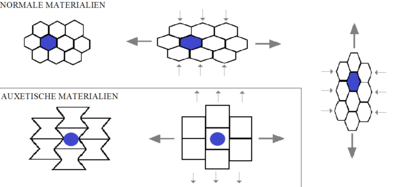拉脹材料

拉脹材料(Auxetics)也稱為負泊松比材料,是泊松比為負值的结构或材料[1]。一般材料在拉伸時,垂直于拉伸方向的部份會收縮。但拉脹材料在拉伸時,垂直拉伸方向的部份會膨脹,這是因為其特殊內部構造,以及在單軸施力下的形變方式有關。拉脹材料可能是單分子、晶體,或是特別的巨觀結構。
有拉脹特性的材料及結構多半會有高吸震及高斷裂抵抗的能力。拉脹材料可用在像防彈背心[2]、包裝材料、護膝及護肘、強健吸震材料及膠棉拖把。
歷史
[编辑]auxetic一詞源自希腊文的αὐξητικός(auxetikos),意思是「傾向於增加」。這個詞是由艾希特大學的Ken Evans教授所創[3][4]。
由柏林的研究者K. Pietsch在1978年發明的RFS結構(鑽石摺疊結構),是首批人工合成的拉脹材料之一[5],K. Pietsch沒有使用auxetic一詞,不過他第一個描述其底層的槓桿特性以及其非線性的力學特性,因此視為是拉脹網狀材料的發明者。 最早發表的負泊松常數論文是由A. G. Kolpakov在1985年提出《確認彈性網路的平均特性》(Determination of the average characteristics of elastic frameworks)。下一個有關合成拉脹材料的論文是在1987年的《科學》期刊,標題是《負泊松比的泡沬結構》(Foam structures with a Negative Poisson's Ratio)[6],是威斯康星大学麦迪逊分校的R.S. Lakes所提出。auxetic一詞的使用大約是在1991年開始[7]。在1985年開始發表用週期性凹六邊形單元(有負泊松比特性)建構複合結構的設計[8][9][10][11]。
特性
[编辑]
一般而言,拉脹材料是低密度的物質,因此其中允許有類似槓桿,可以變形的拉脹微結構[12]。
巨觀下,拉脹特性可以用非弹性的弦繞在弹性的繩子上來說明。當結構的末端受力拉開時,非弹性的弦伸直,弹性繩伸展並繞在其周圍,因此增加了結構的有效體積。巨觀下的拉脹特性也可以用來開發有強化機能的產品,例如由Grima及Evans開發,以拉脹可旋轉三角形結構為基礎的鞋子[13][14][15]
常見的拉脹材料
[编辑]以下一些拉脹材料的例子:
- 拉脹聚氨酯泡沫[16][17]。
- α-方矽石[18]。
- 特定的岩石及礦物[19]。
- 石墨烯,可以透過引入晶格空位使其有拉脹性[20][21]。
- 活的動物骨骼組織(這個只是推測)[19]。
- 在正常運動範圍內的肌腱[22]。
- 特殊的聚四氟乙烯聚合物,例如Gore-Tex[23]。
- 一些特殊的紙張。若紙張在平行紙面的方向受力拉伸,由於其網狀的結構,其厚度也會增加[24][25]
- 一些摺紙形成的結構,例如鑽石摺疊結構(Diamond-Folding-Structure、也簡稱為RFS)、人字纹摺疊結構(FFS)或是三浦摺疊[26][27],或是由這些摺疊衍生的週期性圖案[28][29]。
- 一些為呈現負泊松比而設計的特製結構[30][31]。
- 鏈狀有機分子。近期的研究發現像是n-烷烃或是類似結構的有機晶體可能會有拉脹特性[32]。
- 加工過的針刺不織布。因為其纖維的網狀結構,應用熱和壓力的加工方案可以讓不織布具有拉脹特性[33][34]。
木栓不是拉脹材料,但其泊松比幾乎為0,因此適合用來作酒瓶的瓶塞[35][36]
相關條目
[编辑]參考資料
[编辑]- ^ Nana Ho. 柚子帽是真的!BMW 參考柚子皮結構做防護配件,保護性能提升 20%. 科技新報. 2017-10-04 [2019-08-08]. (原始内容存档于2019-08-07).
- ^ Hook's law. The Economist. 2012-12-01 [2013-03-01]. (原始内容存档于2013-02-28).
- ^ Quinion, Michael, Auxetic, 1996-11-09 [2009-01-02], (原始内容存档于2009-02-17).
- ^ Evans, Ken, Auxetic polymers: a new range of materials., Endeavour, 1991, 15 (4): 170–174, doi:10.1016/0160-9327(91)90123-S.
- ^ RFS-Struktur (Rauten-Falt-Struktur) (页面存档备份,存于互联网档案馆), In: Materialblog.de
- ^ Lakes, R.S., Foam structures with a negative Poisson's ratio, Science, 1987-02-27, 235 (4792): 1038–40, Bibcode:1987Sci...235.1038L, PMID 17782252, doi:10.1126/science.235.4792.1038.
- ^ Evans, Ken, Auxetic polymers: a new range of materials, Endeavour, 1991, 15 (4): 170–174, doi:10.1016/0160-9327(91)90123-S.
- ^ Kolpakov, A.G. Determination of the average characteristics of elastic frameworks. Journal of Applied Mathematics and Mechanics. 1985, 49 (6): 739–745. Bibcode:1985JApMM..49..739K. doi:10.1016/0021-8928(85)90011-5.
- ^ Almgren, R.F. An isotropic three-dimensional structure with Poisson's ratio=-1. Journal of Elasticity. 1985, 15 (4): 427–430. doi:10.1007/bf00042531.
- ^ Theocaris, P.S.; Stavroulakis, G.E.; Panagiotopoulos, P.D. Negative Poisson's ratio in composites with star-shaped inclusions: a numerical homogenization approach .. Archive of Applied Mechanics. 1997, 67 (4): 274–286. Bibcode:1997AAM....67..274T. doi:10.1007/s004190050117.
- ^ Theocaris, P.S.; Stavroulakis, G.E. The homogenization method for the study of variation of Poisson's ratio in fiber composites. Archive of Applied Mechanics. 1998, 69 (3–4): 281–295. Bibcode:1998AAM....68..281T. doi:10.1007/s004190050165.
- ^ A stretch of the imagination - 7 June 1997 - New Scientist Space. [2019-08-07]. (原始内容存档于2015-05-01).
- ^ Grima, JN; Evans, KE. Auxetic behavior from rotating squares. Journal of Materials Science Letters. 2000, 19 (17): 1563–1565. doi:10.1023/A:1006781224002.
- ^ Grima, JN; Evans, KE. Auxetic behavior from rotating triangles. Journal of Materials Science. 2006, 41 (10): 3193–3196. Bibcode:2006JMatS..41.3193G. doi:10.1007/s10853-006-6339-8.
- ^ Nike Free 2016 product press release. (原始内容存档于2018-11-05).
- ^ Li, Yan; Zeng, Changchun. On the successful fabrication of auxetic polyurethane foams: Materials requirement, processing strategy and conversion mechanism. Polymer. 2016, 87: 98–107. doi:10.1016/j.polymer.2016.01.076.
- ^ Li, Yan; Zeng, Changchun. Room‐Temperature, Near‐Instantaneous Fabrication of Auxetic Materials with Constant Poisson's Ratio over Large Deformation. Advanced Materials. 2016, 28 (14): 2822–2826. PMID 26861805. doi:10.1002/adma.201505650.
- ^ Yeganeh-Haeri, Amir; Weidner, Donald J.; Parise, John B. Elasticity of α-Cristobalite: A Silicon Dioxide with a Negative Poisson's Ratio. Science. 1992-07-31, 257 (5070): 650–652. Bibcode:1992Sci...257..650Y. ISSN 0036-8075. PMID 17740733. doi:10.1126/science.257.5070.650 (英语).
- ^ 19.0 19.1 Burke, Maria, A stretch of the imagination, New Scientist, 1997-06-07, 154 (2085): 36 [2019-08-07], (原始内容存档于2015-05-01)
- ^ Grima, J. N.; Winczewski, S.; Mizzi, L.; Grech, M. C.; Cauchi, R.; Gatt, R.; Attard, D.; Wojciechowski, K.W.; Rybicki, J. Tailoring Graphene to Achieve Negative Poisson's Ratio Properties. Advanced Materials. 2014, 27 (8): 1455–1459. PMID 25504060. doi:10.1002/adma.201404106.
- ^ Grima, Joseph N.; Grech, Michael C.; Grima‐Cornish, James N.; Gatt, Ruben; Attard, Daphne. Giant Auxetic Behaviour in Engineered Graphene. Annalen der Physik. 2018, 530 (6): 1700330. Bibcode:2018AnP...53000330G. ISSN 1521-3889. doi:10.1002/andp.201700330 (英语).
- ^ Gatt R, Vella Wood M, Gatt A, Zarb F, Formosa C, Azzopardi KM, Casha A, Agius TP, Schembri-Wismayer P, Attard L, Chockalingam N, Grima JN. Negative Poisson's ratios in tendons: An unexpected mechanical response. Acta Biomater. 2015, 24: 201–208. PMID 26102335. doi:10.1016/j.actbio.2015.06.018.
- ^ Auxetic materials, 2001-03-09 [2009-01-02], (原始内容存档于2008-08-11).
- ^ Baum et al. 1984, Tappi journal, Öhrn, O. E. (1965): Thickness variations of paper on stretching, Svensk Papperstidn. 68(5), 141.
- ^ Verma, Prateek; Shofner, ML; Griffin, AC. Deconstructing the auxetic behavior of paper. Physica Status Solidi B. 2013, 251 (2): 289–296. Bibcode:2014PSSBR.251..289V. doi:10.1002/pssb.201384243.
- ^ Mark, Schenk. Folded Shell Structures, PhD Thesis (PDF). University of Cambridge, Clare College. 2011 [2019-08-07]. (原始内容存档 (PDF)于2017-03-25).
- ^ Lv, Cheng; Krishnaraju, Deepakshyam; Konjevod, Goran; Yu, Hongyu; Jiang, Hanqing. Origami based Mechanical Metamaterials. Scientific Reports. 2015, 4: 5979. PMC 4124469
 . PMID 25099402. doi:10.1038/srep05979.
. PMID 25099402. doi:10.1038/srep05979.
- ^ Eidini, Maryam; Paulino, Glaucio H. Unraveling metamaterial properties in zigzag-base folded sheets. Science Advances. 2015, 1 (8): e1500224. Bibcode:2015SciA....1E0224E. ISSN 2375-2548. PMC 4643767
 . PMID 26601253. arXiv:1502.05977
. PMID 26601253. arXiv:1502.05977  . doi:10.1126/sciadv.1500224.
. doi:10.1126/sciadv.1500224.
- ^ Eidini, Maryam. Zigzag-base folded sheet cellular mechanical metamaterials. Extreme Mechanics Letters. 2016, 6: 96–102. arXiv:1509.08104
 . doi:10.1016/j.eml.2015.12.006.
. doi:10.1016/j.eml.2015.12.006.
- ^ Tiemo Bückmann; et al. Tailored 3D Mechanical Metamaterials Made by Dip-in Direct-Laser-Writing Optical Lithography. Advanced Materials. 2012-05, 24 (20): 2710–2714. PMID 22495906. doi:10.1002/adma.201200584.
- ^ Grima‐Cornish, James N.; Grima, Joseph N.; Evans, Kenneth E. On the Structural and Mechanical Properties of Poly(Phenylacetylene) Truss-Like Hexagonal Hierarchical Nanonetworks. Physica Status Solidi B. 2017, 254 (12): 1700190. Bibcode:2017PSSBR.25400190G. ISSN 1521-3951. doi:10.1002/pssb.201700190. hdl:10871/31485 (英语).
- ^ Stetsenko, M. Determining the elastic constants of hydrocarbons of heavy oil products using molecular dynamics simulation approach. Journal of Petroleum Science and Engineering. 2015, 126: 124–130. doi:10.1016/j.petrol.2014.12.021.
- ^ Verma, Prateek; Lin, A; Wagner, KB; Shofner, ML; Griffin, AC. Inducing out-of-plane auxetic behavior in needle-punched nonwovens. Physica Status Solidi B. 2015, 252 (7): 1455–1464. Bibcode:2015PSSBR.252.1455V. doi:10.1002/pssb.201552036.
- ^ Verma, Prateek; Shofner, Meisha L.; Lin, Angela; Wagner, Karla B.; Griffin, Anselm C. Induction of auxetic response in needle-punched nonwovens: Effects of temperature, pressure, and time. Physica Status Solidi B. 2016, 253 (7): 1270–1278. ISSN 1521-3951. doi:10.1002/pssb.201600072 (英语).
- ^ Stavroulakis, G.E. Auxetic behaviour: Appearance and engineering applications. Physica Status Solidi B. 2005, 242 (3): 710–720. Bibcode:2005PSSBR.242..710S. doi:10.1002/pssb.200460388.
- ^ Kaminakis, N.T.; Stavroulakis, G.E. Topology optimization for compliant mechanisms, using evolutionary-hybrid algorithms and application to the design of auxetic materials. Composites Part B: Engineering. 2012, 43 (6): 2655–2668. doi:10.1016/j.compositesb.2012.03.018.
